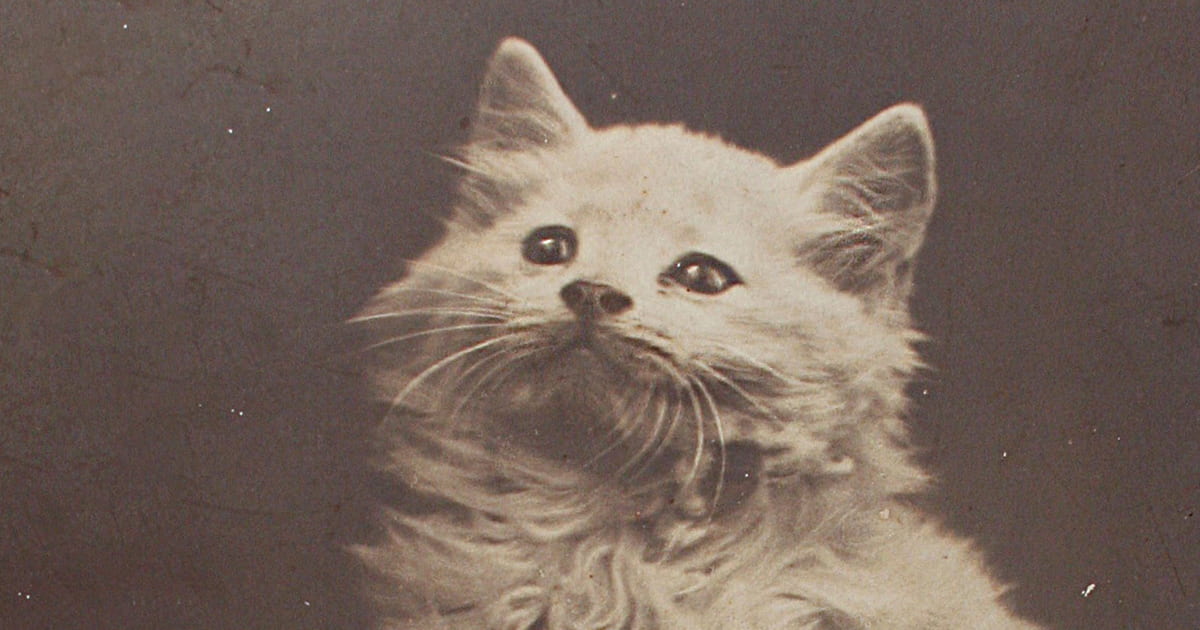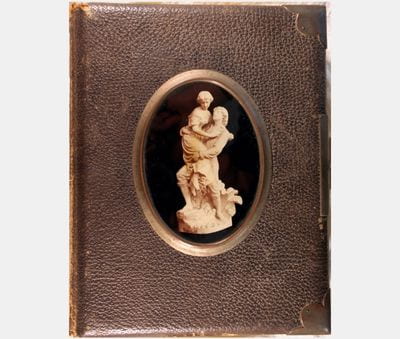To mark this year’s 20th anniversary of Special Collections, the curators have selected some intriguing items for the Twenty at 20 series. Here is number 11.
Kittens and cameos
Special Collections houses many vintage photographs and postcards in its collections. One of the more curious collections was donated to the Fine Arts Library in the late 1970s by sculptor and University of Auckland Fine Arts Professor, Paul Beadle. The collection was gifted to Professor Beadle by the Stebbing family of Herne Bay, Auckland, who discovered the treasures hidden away in an old Australian cedar chest. The contents of the chest included a portrait album of family photographs with a large cameo embedded on the cover, and ephemera and memorabilia.1
Not only does the Stebbing family papers represent a who’s-who of Auckland photographic studios in the early 20th century, but they also contain several other curious items. One is an unusual, oversized postcard of a kitten titled ‘Little all alone’, created sometime between 1910 and 1930 by postcard publishers J. Beagles and Co., London (1881-1939). Mainly known for their postcards depicting royalty, famous celebrities, and action scenes from plays, Beagles also created a series of novelty postcards.2 All of the company’s cards were numbered, with one sequence including an alphabetical suffix; ‘Little all alone’, numbered P927.G, appears to be part of this set.
What makes ‘Little all alone’ so interesting is that it is made in bas-relief. This process means that while the back of the card is flat, the kitten’s head has a deeply embossed, raised texture. Although difficult to capture here, it gives parts of the image a strange, three-dimensional look and feel. The technique for producing these cards was patented by American company Taber Bas Relief Photo, circa 1895. From 1908, however, several printers in the United Kingdom were able to use the technique under licence.3
A legacy of music production
The Stebbing family were early pioneers of the New Zealand music industry, and their recording studio, ‘Stebbing’s Recording and Sound Company (circa 1940s-1960s), worked with of some of the country’s most significant musicians, including Ray Columbus, and the La De Da’s.4 Later, under the name Zodiac records, the label produced music by Split Enz, Bunny Walters, Dragon, and Murray Grindlay’s most loved jingles (including one of the country’s most iconic and longest running TV adds, The Great Crunchie Train Robbery advert).5
While ‘Little all alone’ is one of the quirkier items in the collection, this, and the beautiful silver-worked Victorian-era portrait album are worth a visit to Special Collections to explore further.
Nigel Bond, Special Collections
References
1. Stebbing family papers. MSS & Archives FA 2012/07. Special Collections, Te Tumu Herenga Libraries and Learning Services.
2. British Museum. https://www.britishmuseum.org/collection/term/BIOG247972
3. Method of producing embossed photographs. https://patents.google.com/patent/US556591A/en?q=taber+556591 https://community.ebay.com/t5/Postcard-Collectors-Group/Bas-Relief-postcards/td-p/9765061
4. The Stebbing legacy. https://www.audioculture.co.nz/articles/the-stebbing-legacy
5. New Zealand’s most iconic ad: The Great Crunchie Train Robbery. https://www.rnz.co.nz/national/programmes/eyewitness/audio/2018805102/new-zealand-s-most-iconic-ad-the-great-crunchie-train-robbery


